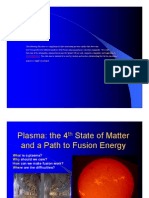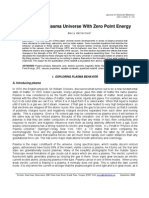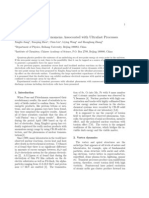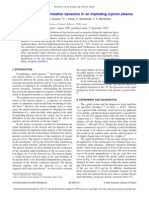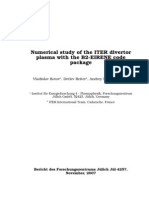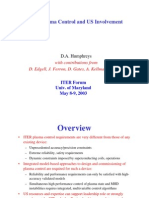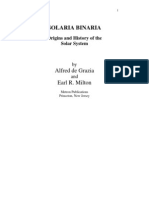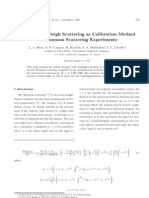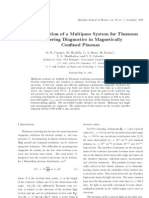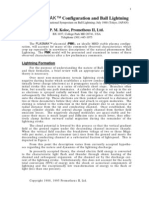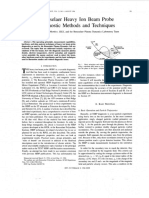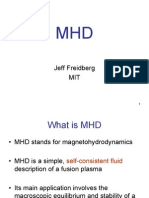T. Kenneth Fowler - Nuclear Power-Fusion
T. Kenneth Fowler - Nuclear Power-Fusion
Uploaded by
MsdsxCopyright:
Available Formats
T. Kenneth Fowler - Nuclear Power-Fusion
T. Kenneth Fowler - Nuclear Power-Fusion
Uploaded by
MsdsxOriginal Title
Copyright
Available Formats
Share this document
Did you find this document useful?
Is this content inappropriate?
Copyright:
Available Formats
T. Kenneth Fowler - Nuclear Power-Fusion
T. Kenneth Fowler - Nuclear Power-Fusion
Uploaded by
MsdsxCopyright:
Available Formats
Nuclear powerfusion
T. Kenneth Fowler
University of California, Berkeley, 4167 Etcheverry Hall, Berkeley, California 94720-1730
In the 1990s, experiments in tokamak magnetic fusion devices have nally approached breakeven power out equal to power inat fusion power levels exceeding 10 MW, and great progress has also been made with inertial-connement fusion laser experiments. Based on these results, the requirements to achieve ignition and high-energy gain are now fairly clear for both approaches. This article focuses on developments in modern plasma physics that led to these achievements and outlines the historical development of the eld. Topics include the stability of magnetic elds, eld reconnection and the magnetic dynamo, turbulent heat transport, and plasma absorption of intense beams of light. The article concludes with a brief discussion of future research directions. [S0034-6861(99)00902-2]
I. INTRODUCTION
The earliest speculations about nuclear powerrst, about nuclear fusionfollowed soon after the publication of Albert Einsteins special theory of relativity. A story related by Edward Teller tells of the young George Gamows being offered, in 1929, the nightly use of the full electric power grid of Leningrad if he would undertake to create in the laboratory the fusion energy that Atkinson and Houtermans were claiming to be sufcient to explain stars (Teller, 1981). Then, when ssion was discovered in 1939, fusion took a back seat as the more readily exploitable ssion process forged ahead, culminating in the rst ssion power reactors in the 1950s. While the early success of ssion reactors came at dazzling speed, the story of fusion powerstill in the research stageis one of persistent determination driven on the one hand by the alluring goal of virtually unlimited and environmentally attractive nuclear power, and on the other by the intellectual appeal of unprecedented technical and scientic challenges that have created the eld of modern plasma physics. Both the allure and the challenges of fusion arise from the nature of the fusion process. Fusion fuel is abundant and cheap, the most easily exploitable fuels being deuterium, occurring naturally in all water, and tritium, which can easily be manufactured inside the fusion reactor by the neutron bombardment of lithium, also abundant in nature. And fusion does not produce nuclear waste directly, though tritium is mildly radioactive and neutron activation of the reactor chamber dictates which structural materials are most useful to minimize waste disposal of components discarded in maintenance or the entire reactor assembly at the end of its life. However, whereas ssion occurs at normal temperatures, fusion occurs only at the extreme temperatures characteristic of stars (aside from muon catalysis, which does not require high temperatures but thus far poses other unsolved problems). The fuel with the lowest kindling point is a mixture of deuterium and tritium that ignites at temperatures around 50 keV or 50 million degrees Kelvin. At such high temperatures, the fuel becomes a fully ionized gas, or plasma, hence the prominence of plasma physics in fusion research.
S456
Reviews of Modern Physics, Vol. 71, No. 2, Centenary 1999
Two approaches to obtaining high-temperature plasmas have dominated the eld. One is the connement of the fuel at moderate pressure by means of magnetic elds, and the othercalled inertial-connement fusion (ICF)utilizes solid DT targets heated by intense laser beams or ion beams. Impressive progress has been made. While self-sustaining ignition has not yet been achieved, experiments in tokamak magnetic fusion devices have approached breakevenpower out equal to the power inat fusion power levels exceeding 10 MW (Strachan et al., 1994; JET Team, 1997), and great progress has also been made with ICF laser experiments (Lindl, 1995). Based on these results, the physics requirements for achieving ignition are now fairly clear, for both approaches (Fowler, 1997). In this article, we shall focus on the scientic developments that led to these achievements. Largely through the impetus of fusion research, plasma physics has reached a level of sophistication comparable to older elds of applied science, such as solid-state physics and uid mechanics. Mastery of plasma physics at a level adequate for understanding fusion plasmas requires a complete synthesis of classical physics. A resurgence of interest in this fundamental discipline has beneted astrophysics, space physics, and applied mathematics and has trained many scientists and engineers who have made outstanding contributions in industry and academia.
II. CREATING MAGNETIC FUSION SCIENCE
Magnetic fusion research began in the 1950s, initially in secret but soon declassied, in 1958, in recognition of the fact that the research would benet greatly from a concerted world effort and had little connection with nuclear weapons technology or weapons proliferation. Research on the ICF approach began about a decade later and remained classied for a longer time, especially in the U.S., but it too is now largely declassied. The value of international cooperation in fusion research cannot be overstated, in terms both of science and of its contributions to East-West communication during the Cold War. A famous event in fusion history, which heralded the dominant role of the Russian tokamak in magnetic fusion research, was the airlift to Moscow, in
0034-6861/99/71(2)/456(4)/$15.80 1999 The American Physical Society
T. K. Fowler: Nuclear powerfusion
S457
1969, of a British research team using their own equipment to verify Russian claims that they had achieved new records of plasma connement and the thenunprecedented temperature of 10 million degrees Kelvin. This event, soon followed by conrming experiments in the U.S. and Europe, paved the way for the large tokamak facilities constructed in aftermath of the oil crises of the 1970sthe facilities that have now achieved near-breakeven in the 1990s. The development of plasma physics for magnetic fusion research has been strongly inuenced by the requirements for achieving ignition. It is useful to think of ignition requirements in two stepsrst, the creation of a stable magnetic conguration to conne the fuel plasma, and, second, doing so at a critical size large enough so that the fusion reactions heat the fuel faster than the heat can leak away. Examining the history of the tokamak in light of these two requirements will serve to illustrate how and why fusion science developed as it did. A more thorough discussion of tokamaks and other magnetic congurations can be found in Teller (1981) and Shefeld (1994) and a discussion of fusion nuclear engineering in Holdren et al. (1988), which compares safety and nuclear waste characteristics of fusion and ssion reactors. The starting point is a magnetic conguration to conne the plasma in a state of equilibrium between magnetic forces and pressure forces. Whereas gravitational forces are symmetrical, so that stars are spheres, the magnetic force is two-dimensional, acting only perpendicular to a current, so that a magnetically conned plasma is a cylinder. The tokamak, invented by Igor Tamm and Andrei Sakharov in the Soviet Union, is descended from the linear pinch, a plasma column carrying currents along its length whose mutual attraction constricts the plasma away from the walls of the tube that contains it, as discovered by Willard Bennett in 1934. Early linear pinch experiments at Los Alamos and elsewhere proved to be unstable, and heat leaked out the ends, defects remedied in the tokamak by bending the cylinder into a closed ring or torus, stabilized by a strong eld generated by a solenoid wrapped around the toroidally shaped vacuum vessel. Bending the current channel into a circle requires an additional vertical eld perpendicular to the plane of the torus. Thus the tokamak solves the requirement of stable connement using three sources of magnetic eldthe vertical eld to conne the current, the current to conne the plasma, and the solenoid to stabilize the current channel. The stability of the tokamak follows from its magnetic geometry, in which the eld lines produced by the toroidal solenoid are given a helical twist by the current. Ideally, these twisting eld lines trace out symmetric, closed toroidal surfacescalled ux surfacesnested one inside the other. A similar concept, not requiring currents in the plasma, is the stellarator, invented by Lyman Spitzer in the early 1950s. A major theoretical achievement, published by Bernstein, Frieman, Kruskal, and Kulsrud (1958), is the energy principle, whereby the stability of tokamaks or any other magnetic conguraRev. Mod. Phys., Vol. 71, No. 2, Centenary 1999
tion can be determined exactly within the constraints of magnetohydrodynamic (MHD) theory borrowed from astrophysics, in which the plasma is treated as a uid represented by averaging the equations of motion over all particles in the plasma. By the late 1960s, fusion scientists had repaid their debt to astrophysics by their own extensions of the theory including the effects of resistivity due to Coulomb collisions between electrons and ions. In fusion devices carrying current, the magnetic structure can be disrupted by breaking or tearing of the eld lines due to resistivityan example of magnetic reconnection prevalent in many astrophysical phenomena and in planetary magnetic elds, and an early example of chaos in which the current channel breaks up into laments that create islands in the eld structure or eld lines wandering out of the machine. For tokamaks, the study of tearing was motivated by occasional violent disruptions of the current channel, which must be understood and controlled to avoid severe damage to the machine. In other magnetic connement geometries, discussed below, tearing can actually serve the useful purpose of selforganization of plasma currents into a stable conguration. Thus we see how, in concentrating on the creation of stable magnetic congurations to meet a basic ignition requirement, fusion science has evolved a fundamental understanding of magnetized plasmas that has simultaneously contributed to solving a practical problem in tokamak design, shed light on phenomena ubiquitous in nature, contributed to the development of chaos theory in applied mathematics and many elds of physics, and stimulated new inventions in fusion research. Of even greater impact on plasma physics, and on our understanding of turbulence in uids, has been the extensive body of experimental and theoretical work aimed at the second ignition requirement, to determine the critical size at which fusion power production exceeds heat transport out of the plasma. Given a stable magnetic structure, heat can still be transported by entropy generation associated with processes not included in the energy principle, which assumes perfect conductivity along eld lines. One such process, already mentioned, is resistivity, for which the entropy generation rate can be calculated accurately. Classical resistive transport, due to Coulomb collisions, is relatively weak and diminishes greatly at high temperatures. More important but more difcult to calculate is transport due to microscopic turbulence associated with the buildup of weak electric elds parallel to the magnetic eld B. Though usually too weak to affect the resistivity in fusion plasmas, these weak parallel electric elds also imply components perpendicular to B that cause plasma particles to execute cycloidal orbits drifting between ux surfaces. Small perturbations grow into turbulence if the drifting motion is amplied, as can be true in tokamaks for perturbation wavelengths a few times the orbital radius of ions spinning in the magnetic eld. At this time, the main information about turbulent transport is obtained empirically, by tting formulas to the results of
S458
T. K. Fowler: Nuclear powerfusion
numerous tokamak experiments, guided in part by dimensional analysis to suggest scaling laws appropriate for particular physical processes. Computer codes, called particle-in-cell (PIC) codes, have been used to simulate drift motion turbulence (drift waves) by following the detailed motion of thousands of particles representing charge clouds generated by the turbulence. Other codes, focusing on magnetic turbulence, follow the nonlinear evolution of tearing modes. Calibration of code results with experimental data shows promise, though machine designers still must rely heavily on the empirical approach. Theoretically, the potential for microturbulence is studied by examining the stability properties of the Vlasov equation, in which ions and electrons are represented by distribution functions f(x,v,t) in the phase space of position x and velocity v. The Vlasov equation is just the continuity equation in this phase spacea Liouville equation with Hamiltonian forces, coupled to Maxwells equations in which the charge and current densities are obtained by velocity averages of the Vlasov distribution function. The MHD uid equations can be derived as velocity moments of the Vlasov equation. Stability is studied by searching for growing eigenmodes of the Vlasov equation linearized around an equilibrium distribution. It can also be shown that, as for the MHD equations, there must exist a corresponding energy principle for the linearized Vlasov equation; correspondingly, the nonlinear theory should possess a generalized entropy and associated free energy from which transport could be derived. Though useful conceptually, this approach has not yet yielded many calculational results (Fowler, 1968). At the time this article appears, a promising new directionalready being exploited experimentallyis the reduction of transport by the deliberate introduction of sheared ows and reversed magnetic shear that break up the collective motions produced by turbulence. Initially discovered experimentally in the 1980s as the H mode of operation with reduced transport at the plasma edge, with theoretical guidance this technique has now been extended throughout the plasma volume, resulting in heat transport associated with the ions at the minimum rates allowed by Coulomb collisions, though electron-related transport still appears to be governed by turbulence. As a nal example of fusion-inspired plasma physics, we return to the tokamak and its requirement for a strong current circulating around the torus. In existing tokamaks, the current is induced by the changing ux of a transformer, the plasma ring itself acting as the secondary winding, but already methods have been demonstrated that can drive a steady current (energetic atomic beams, microwaves, etc.). All such methods would be too inefcient, producing unwanted heating, were it not for the fact that, miraculously, the tokamak can generate most of its own current, called the bootstrap current. Again the reason lies in the equation of motion, now having to do with the nonuniformity of the magnetic eld in a tokamak, which causes additional oscillatory
Rev. Mod. Phys., Vol. 71, No. 2, Centenary 1999
drift motion due to changes in the orbital radius as particles spin around eld lines. The enhanced transport of particles due to collisions among these magnetically drifting orbits, called neoclassical transport, drives a dynamo-like response as the conducting plasma ows across magnetic eld lines, and this dynamo drives the bootstrap current. It is neoclassical heat transport by ions that gives the minimum possible rate of entropy generation and the minimum possible heat transport in a tokamak. A different mechanism of current generation is the magnetic dynamo, now arising from the statistical average of the v B force in a magnetic eld undergoing turbulent uctuations due to tearing and reconnection. Whereas the collisional bootstrap current creates magnetic ux, this magnetic dynamo mainly reorganizes the eld due to the approximate conservation of a quantity called helicity, given by an integral of the scalar product of B and the vector potential A. Though of limited importance in tokamaks, in which tearing is largely suppressed by the strong toroidal eld, in other concepts, such as the reversed-eld pinch (RFP), the plasma generates its own toroidal eld as it relaxes toward a state of minimum magnetic energy at xed helicityknown as Taylor relaxation (Taylor, 1986). An open question at this time is the extent to which turbulent relaxation creates unacceptable heat transport as the eld continually readjusts to compensate for resistive decay near the plasma boundary where the temperature is lowest and the resistivity is highest.
III. INERTIAL-CONFINEMENT FUSION
Turning briey to the ICF approach, we nd entirely different physics issues, reecting an entirely different solution to the basic requirements of a stable assembly of fuel and the critical size to achieve ignition. Though heating the solid target also forms a plasma, its density is so high that plasma turbulence is irrelevant in calculating the critical size. However, achieving a useful critical size requires that the fuel rst be compressed to densities many hundreds of times that of ordinary materials. This is accomplished by heating the spherical target uniformly from all sides, whereby the intense heating of the surface creates an inward implosion of the fuel as the surface layer, called the ablator, explodes outward. At the intensity of giant lasers now available, implosion pressures of millions of atmospheres are created, compressing the fuel to 100 times liquid density, and a 1000fold or more compression should be possible. The physics issues concern mainly the uniformity of illumination and target design requirements to suppress hydrodynamic instability that amplies imperfections in the surface nish. Plasma physics enters mainly in ensuring efcient absorption of the laser energy before the beams are reected at the cutoff density at which the laser frequency matches the plasma frequency (the same condition as that for the reection of light from an ordinary mirror). Two methods are employed, the direct-
T. K. Fowler: Nuclear powerfusion
S459
drive approach, in which laser beams shine directly on the target, and indirect drive, in which the target is mounted inside a tiny metal cylinder, called a hohlraum, which converts laser light to x rays that in turn irradiate the target. For both approaches, efcient absorption either in a plasma cloud surrounding the ablator for direct drive, or in the metallic plasma formed where laser beams strike the hohlraum wall for indirect drive requires the use of ultraviolet light to penetrate to densities where collisional absorption dominates over collective laser-plasma interactions (Lindl, 1995). The invention at the University of Rochester in the late 1970s of efcient methods to convert the infrared light produced by glass lasers into ultraviolet light was an important milestone in ICF research.
IV. FUTURE DIRECTIONS
The spherical tokamak is an innovative exception designed to minimize this difculty (Peng and Strickler, 1986). For ICF, the immediate goal is ignition, in the National Ignition Facility now under construction in the U.S. Application of the concept to electric power production will require new laser technology, or perhaps ion beams, capable of rapid repetitionseveral times per secondand greater efciency than existing glass lasers. An innovative means for reducing the laser energy required for compression is the fast ignitor, using a small but very-high-power laser to ignite the target after it has been compressed Tabak et al. (1994).
REFERENCES Bernstein, I. B., E. A. Frieman, M. D. Kruskal, and R. M. Kulsrud, Proc. Soc. London, Ser. A 244, 17 (1958). Fowler, T. K., 1968, in Advances in Plasma Physics, edited by A. Simon and W. B. Thompson (Interscience, New York), Vol. 1, p. 201. Fowler, T. K., 1997, The Fusion Quest (Johns Hopkins University, Baltimore, MD). Holdren, J. P., D. H. Berwald, R. J. Budnitz, J. G. Crocker, J. G. Delene, R. D. Endicott, M. S. Kazimi, R. A. Krakowski, B. G. Logan, and K. R. Schutty, 1988, Fusion Technol. 13, 7. JET Team, 1997, Plasma Phys. Controlled Fusion (Suppl.) 2B, 1. Lindl, John, 1995, Phys. Plasmas 2, 3933. Peng, Y.-K., and D. J. Strickler, 1986, Nucl. Fusion 26, 769. Shefeld, John, 1994, Rev. Mod. Phys. 66, 1015. Strachen, J. D., and TFTR Team, 1994, Phys. Rev. Lett. 72, 3526. Tabak, Max, J. Hammer, M. E. Glinsky, W. L. Kruer, S. C. Wilks, J. Woodworth, E. M. Campbell, M. D. Perry, and R. J. Mason, 1994, Phys. Plasmas 1, 1626. Taylor, J. B., 1986, Rev. Mod. Phys. 58, 741. Teller, E., 1981, Ed., Fusion (Academic, New York), Vol. I, Parts A, B.
Magnetic fusion research is now focused on an international effort to achieve ignition in a tokamak and on improvements in the concept, including other means for creating the nested toroidal ux surfaces so successfully utilized to conne plasmas in tokamaks. A central issue is to what extent one should rely on internal currents, as the tokamak does. As noted earlier, the stellarator avoids internal currents altogether by creating closed toroidal ux surfaces. Its external helical coils impart a twist to the eld lines as current does. At the opposite extreme are the reversed-eld pinch devices, with only a weak external toroidal eld, and a very compact device called the spheromak, which has no external toroidal eld and relies totally on Taylor relaxation to create the desired eld conguration (Taylor, 1986). This is more than an intellectual exercise, since the size and cost of toroidal connement devices tends to increase as they rely more heavily on externally generated toroidal elds, requiring large coils looping through the plasma torus.
Rev. Mod. Phys., Vol. 71, No. 2, Centenary 1999
You might also like
- WATER: THE KEY TO NEW ENERGY: Cavitating Electrolyzers & Zero-Point EnergyFrom EverandWATER: THE KEY TO NEW ENERGY: Cavitating Electrolyzers & Zero-Point EnergyRating: 5 out of 5 stars5/5 (2)
- Freidberg, J. P. Rev. Mod. Phys. 54, 801 (1982) - Ideal Magnetohydrodynamic Theory of Magnetic Fusion SystemsDocument103 pagesFreidberg, J. P. Rev. Mod. Phys. 54, 801 (1982) - Ideal Magnetohydrodynamic Theory of Magnetic Fusion SystemsjahernandesNo ratings yet
- Tesla Tech Rev18Document16 pagesTesla Tech Rev18Nihil In-lineNo ratings yet
- nf_50th_5_SmirnovDocument8 pagesnf_50th_5_SmirnovtheturinglabNo ratings yet
- Modern PhysicsDocument4 pagesModern PhysicsSamuel VivekNo ratings yet
- TokamakDocument28 pagesTokamakhendro ajahNo ratings yet
- TokamakDocument33 pagesTokamaktheturinglabNo ratings yet
- Nuclear Fusion PowerDocument11 pagesNuclear Fusion PowerAndré RebelloNo ratings yet
- Chemistry Investigatory projectDocument37 pagesChemistry Investigatory projectkarthikdheepika08No ratings yet
- Power From Space - The Correa Invention (1996) - Harold AspdenDocument85 pagesPower From Space - The Correa Invention (1996) - Harold Aspdensterling goinNo ratings yet
- StellaratorDocument19 pagesStellaratortheturinglabNo ratings yet
- Third LawDocument8 pagesThird LawChristeen GarciaNo ratings yet
- Kibble 2015 J. Phys. Conf. Ser. 626 012001Document11 pagesKibble 2015 J. Phys. Conf. Ser. 626 012001cifarha venantNo ratings yet
- One Hundred Years of Quantum Physics: Daniel Kleppner and Roman Jackiw Massachusetts Institute of TechnologyDocument12 pagesOne Hundred Years of Quantum Physics: Daniel Kleppner and Roman Jackiw Massachusetts Institute of TechnologytestNo ratings yet
- PhysicsDocument11 pagesPhysicsnassreal01No ratings yet
- Research On AtomDocument2 pagesResearch On AtomtherelaxedcatspanishNo ratings yet
- Tokamek PLASMA PHYSICSDocument11 pagesTokamek PLASMA PHYSICSSäjidëë KisÅnNo ratings yet
- Khomskii Physics (2009) PDFDocument8 pagesKhomskii Physics (2009) PDFRogerNo ratings yet
- Superconducting MaterialsDocument70 pagesSuperconducting MaterialsRicardo Sant BNo ratings yet
- Nuclear Fusion - Energy For FutureDocument12 pagesNuclear Fusion - Energy For FuturedeepthiNo ratings yet
- Nuclear Fusion in SunDocument5 pagesNuclear Fusion in SunKishore DazzNo ratings yet
- Nuclear FusionDocument6 pagesNuclear FusionmokshNo ratings yet
- Plugin-Plasma 4th State of MatterDocument42 pagesPlugin-Plasma 4th State of Matterr2b2mNo ratings yet
- Wave Trough: Electric ForceDocument12 pagesWave Trough: Electric ForcemichsantosNo ratings yet
- Cern 94 01 V1Document523 pagesCern 94 01 V1mertsekerciNo ratings yet
- Physics 2 20Document8 pagesPhysics 2 20adlei.oliveros1No ratings yet
- A Brief History and Review of AcceleratorsDocument17 pagesA Brief History and Review of AcceleratorsNikolina ŠarčevićNo ratings yet
- Grasso, Rubinstein. Magnetic Fields in The Early Universe (PR348, 2001) (104s)Document104 pagesGrasso, Rubinstein. Magnetic Fields in The Early Universe (PR348, 2001) (104s)wexlerNo ratings yet
- Hydrogen Fusion Power TechnologyDocument11 pagesHydrogen Fusion Power TechnologyWilly MwangiNo ratings yet
- Introduction To Electrochemistry: The Scope of ElectrochemistryDocument10 pagesIntroduction To Electrochemistry: The Scope of ElectrochemistrymariaNo ratings yet
- Engineering Approaches For Gravity ModificationDocument10 pagesEngineering Approaches For Gravity ModificationsaavfmpfNo ratings yet
- Schapp SchappDocument18 pagesSchapp SchappklausNo ratings yet
- Harold Aspden - Power From Space: The Correa InventionDocument45 pagesHarold Aspden - Power From Space: The Correa InventionSonyRedNo ratings yet
- Aspden Free Energy Collection 3Document3,084 pagesAspden Free Energy Collection 3Dan Beeson100% (1)
- Nuclear FissionDocument10 pagesNuclear Fissionsusan susanNo ratings yet
- Engineering Materials Chapter 1 NanotubesDocument4 pagesEngineering Materials Chapter 1 Nanotubesbharatsharma8706No ratings yet
- Kowsky 1919Document5 pagesKowsky 1919knew999No ratings yet
- I Have Conflated Scalar Energy and Scalar Fields As Well As Longitudinal and Scalar: Not Necessarily The Same: Decouple Them Need To Fix in EditDocument12 pagesI Have Conflated Scalar Energy and Scalar Fields As Well As Longitudinal and Scalar: Not Necessarily The Same: Decouple Them Need To Fix in EditStere Stere100% (2)
- Abdus Salam - Astro-Particle-PhysicsDocument6 pagesAbdus Salam - Astro-Particle-PhysicsVasmazxNo ratings yet
- Resource Letter - Van Der Waals and Casimir-Polder Forces PDFDocument27 pagesResource Letter - Van Der Waals and Casimir-Polder Forces PDFthelordxorNo ratings yet
- Astro NucDocument20 pagesAstro NucHiya MukherjeeNo ratings yet
- Physics Investigatory ProjectDocument28 pagesPhysics Investigatory ProjectUDAYATHKIRANNo ratings yet
- Schapp SchappDocument18 pagesSchapp SchappklausNo ratings yet
- Interplay Between Classical and Quantum MechanicsDocument22 pagesInterplay Between Classical and Quantum Mechanicsrla97623No ratings yet
- FusionDocument2 pagesFusionNavneet KaliaNo ratings yet
- Multivalued Fields In Condensed Matter Electromagnetism and Gravitation Hagen Kleinert 2024 scribd downloadDocument75 pagesMultivalued Fields In Condensed Matter Electromagnetism and Gravitation Hagen Kleinert 2024 scribd downloadbayseberstas100% (4)
- A Plasma Universe With Zero Point EnergyDocument30 pagesA Plasma Universe With Zero Point EnergyFrank Raven100% (2)
- Magnetic Fields in Neutron Stars: A Theoretical PerspectiveDocument11 pagesMagnetic Fields in Neutron Stars: A Theoretical PerspectiveRafael Fuentes BaezaNo ratings yet
- Particle Physics DissertationDocument7 pagesParticle Physics DissertationCustomPapersOnlineCanada100% (1)
- Philosophical Issues in ElectromagnetismDocument16 pagesPhilosophical Issues in ElectromagnetismronNo ratings yet
- The Origin of The: Fundamental or Environmental Research?: Earth's Magnetic FieldDocument4 pagesThe Origin of The: Fundamental or Environmental Research?: Earth's Magnetic Fieldswami061009No ratings yet
- Zalino On BifilarDocument4 pagesZalino On BifilarDilJalaayNo ratings yet
- Valone ElectrograviticsAIAApaper2008Document10 pagesValone ElectrograviticsAIAApaper2008aaa100% (2)
- Charge-Density-Wave Conductors: Articles You May Be Interested inDocument7 pagesCharge-Density-Wave Conductors: Articles You May Be Interested inMiguel Angel Gonzalez JaimesNo ratings yet
- Kendall Lecture 1Document33 pagesKendall Lecture 1PrinceNo ratings yet
- 4.2 the-pioneers-of-atomic-structure-20240430065455tFpFDocument13 pages4.2 the-pioneers-of-atomic-structure-20240430065455tFpFMercy PaduaNo ratings yet
- Magnetoplasmadynamic ThrustersDocument22 pagesMagnetoplasmadynamic ThrustersAdam BruceNo ratings yet
- RMI AndersonDocument11 pagesRMI AndersonRebecca ClarkNo ratings yet
- Zae210481500 PDFDocument28 pagesZae210481500 PDFAJER JOURNALNo ratings yet
- Xingliu Jiang Et Al - Anomalous Nuclear Phenomena Assocoated With Ultrafast ProcessesDocument4 pagesXingliu Jiang Et Al - Anomalous Nuclear Phenomena Assocoated With Ultrafast ProcessesTuoma2No ratings yet
- P. Angelino Et Al - Role of Plasma Elongation On Turbulent Transport in Magnetically Confined PlasmasDocument4 pagesP. Angelino Et Al - Role of Plasma Elongation On Turbulent Transport in Magnetically Confined PlasmasMsdsxNo ratings yet
- J. P. Apruzese Et Al - Comparative Properties of The Interior and Blowoff Plasmas in A Dynamic HohlraumDocument5 pagesJ. P. Apruzese Et Al - Comparative Properties of The Interior and Blowoff Plasmas in A Dynamic HohlraumMsdsxNo ratings yet
- J. Preinhaelter Et Al - Proposal of Quasi-Optical Grill For ITER TokamakDocument4 pagesJ. Preinhaelter Et Al - Proposal of Quasi-Optical Grill For ITER TokamakMsdsxNo ratings yet
- L. Gregorian Et Al - Electron Density and Ionization Dynamics in An Imploding Z-Pinch PlasmaDocument8 pagesL. Gregorian Et Al - Electron Density and Ionization Dynamics in An Imploding Z-Pinch PlasmaMsdsxNo ratings yet
- Vladislav Kotov, Detlev Reiter and Andrey S. Kukushkin - Numerical Study of The ITER Divertor Plasma With The B2-EIRENE Code PackageDocument142 pagesVladislav Kotov, Detlev Reiter and Andrey S. Kukushkin - Numerical Study of The ITER Divertor Plasma With The B2-EIRENE Code PackageMsdsxNo ratings yet
- V.E. Lukash and R.R. Khayrutdinov - Model of Real Time ITER Plasma Position, Shape and Current Control On Base of DINA CodeDocument4 pagesV.E. Lukash and R.R. Khayrutdinov - Model of Real Time ITER Plasma Position, Shape and Current Control On Base of DINA CodeMsdsxNo ratings yet
- D.A. Humphreys Et Al - ITER Plasma Control and US InvolvementDocument14 pagesD.A. Humphreys Et Al - ITER Plasma Control and US InvolvementMsdsxNo ratings yet
- P.L. Kapitza - Plasma and The Controlled Thermonuclear ReactionDocument9 pagesP.L. Kapitza - Plasma and The Controlled Thermonuclear ReactionMsdsxNo ratings yet
- T. Tajima Et Al - Instabilities and Vortex Dynamics in Shear Flow of Magnetized PlasmasDocument17 pagesT. Tajima Et Al - Instabilities and Vortex Dynamics in Shear Flow of Magnetized PlasmasMsdsxNo ratings yet
- Edward J. Hackett Et Al - Tokamaks and Turbulence: Research Ensembles, Policy and Technoscientific WorkDocument21 pagesEdward J. Hackett Et Al - Tokamaks and Turbulence: Research Ensembles, Policy and Technoscientific WorkMsdsxNo ratings yet
- Solaria BinariaDocument313 pagesSolaria BinariaAnonymous snSfklbI8pNo ratings yet
- F.L. Tabarés Et Al - First EIRENE Modelling of A He Plasma. Simulation of Emission Profiles in A TJ-II ECRH PlasmaDocument4 pagesF.L. Tabarés Et Al - First EIRENE Modelling of A He Plasma. Simulation of Emission Profiles in A TJ-II ECRH PlasmaMsdsxNo ratings yet
- L. A. Berni Et Al - Molecular Rayleigh Scattering As Calibration Method For Thomson Scattering ExperimentsDocument5 pagesL. A. Berni Et Al - Molecular Rayleigh Scattering As Calibration Method For Thomson Scattering ExperimentsMsdsxNo ratings yet
- D. O. Campos Et Al - The Application of A Multipass System For Thomson Scattering Diagnostics in Magnetically Con Ned PlasmasDocument5 pagesD. O. Campos Et Al - The Application of A Multipass System For Thomson Scattering Diagnostics in Magnetically Con Ned PlasmasMsdsxNo ratings yet
- PowerPoint PresentationDocument31 pagesPowerPoint PresentationalirafiqNo ratings yet
- ACEE Fusion DistillateDocument34 pagesACEE Fusion DistillateTanvir SNo ratings yet
- Pub1562 WebDocument1,158 pagesPub1562 Webdamp1r100% (1)
- P. M. Koloc - The PLASMAK TM Configuration and Ball LightningDocument20 pagesP. M. Koloc - The PLASMAK TM Configuration and Ball LightningWhiteLighteNo ratings yet
- Some Highlights During 50 Years of Fusion ResearchDocument39 pagesSome Highlights During 50 Years of Fusion Researchhearty sianenNo ratings yet
- Nature Magazine 7160 - 2007-09-20Document135 pagesNature Magazine 7160 - 2007-09-20Roberto KlesNo ratings yet
- Article - 1996 - Island Chain - Manipulation of Islands in A Heliac Vacuum FieldDocument8 pagesArticle - 1996 - Island Chain - Manipulation of Islands in A Heliac Vacuum FieldmoslemNo ratings yet
- Magnetobydrodynamic Equilibrium and Stability of StellaratorsDocument202 pagesMagnetobydrodynamic Equilibrium and Stability of StellaratorsJoann HowardNo ratings yet
- Rensselaer Heavy Ion Beam Probe Diagnostic Methods and TechniquesDocument19 pagesRensselaer Heavy Ion Beam Probe Diagnostic Methods and Techniquesdebjyotibasu.basuNo ratings yet
- Plasma NotesDocument17 pagesPlasma NotesAbdulhadiW.AyyadNo ratings yet
- Hinton 1976Document70 pagesHinton 1976Kush KushwahaNo ratings yet
- MHDDocument57 pagesMHDAsifa AshrafNo ratings yet
- Three-Dimensional Analysis of Tokamaks and Stellarators: Paul R. GarabedianDocument4 pagesThree-Dimensional Analysis of Tokamaks and Stellarators: Paul R. GarabedianMustafa Umut SaracNo ratings yet
- The Wendelstein 7-X Fusion Stellarator Experiment: Mag Fus Energy PG 8Document4 pagesThe Wendelstein 7-X Fusion Stellarator Experiment: Mag Fus Energy PG 8api-368863285No ratings yet
- Presentation On Plasma ConfinementDocument13 pagesPresentation On Plasma Confinementshivamyadav704943No ratings yet
- Hammett 2015 Turbulence SULI All PDFDocument64 pagesHammett 2015 Turbulence SULI All PDFgwhammettNo ratings yet
- Fusion EnergyDocument36 pagesFusion Energytendojude88No ratings yet
- Seminar Report On Fusion Power PlantDocument33 pagesSeminar Report On Fusion Power Plantnavin shukla100% (1)
- Download full Fusion An Introduction to the Physics and Technology of Magnetic Confinement Fusion Second Completely Revised and Enlarged edition Weston M. Stacey ebook all chaptersDocument30 pagesDownload full Fusion An Introduction to the Physics and Technology of Magnetic Confinement Fusion Second Completely Revised and Enlarged edition Weston M. Stacey ebook all chaptersalickbrwon1s100% (5)
- T. Kenneth Fowler - Nuclear Power-FusionDocument4 pagesT. Kenneth Fowler - Nuclear Power-FusionMsdsxNo ratings yet
- Catálogo de Referencias - Power Conversion SystemsDocument60 pagesCatálogo de Referencias - Power Conversion SystemsBENo ratings yet
- Physics ProjectDocument20 pagesPhysics ProjectZenith xNo ratings yet
- The National Academies Press: Plasma Science: Advancing Knowledge in The National Interest (2007)Document38 pagesThe National Academies Press: Plasma Science: Advancing Knowledge in The National Interest (2007)Jameel KhanNo ratings yet
- Computational Mathematics and Physics of Fusion Reactors - Paul R. GarabedianDocument5 pagesComputational Mathematics and Physics of Fusion Reactors - Paul R. GarabediandougnovaesNo ratings yet






















